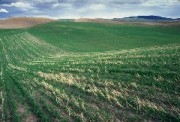
 |
| Scientists - John Williams |
|
Dr. John D. Williams Position: Hydrologist
Email:
Phone: 541-278-4392
|
|
 |
|||
|
Background: John Williams received a BA degree in biology in 1986 and a master's degree in rangeland resources in 1988 from Oregon State University in Corvallis, OR. In 1993, Dr. Williams was awarded a PhD in range science from Utah State University in Logan, UT. Dr. Williams served as lead scientist for the unit's ‘Cropping Systems and Land Management in Dryland Pacific Northwest’ research project from 2000 until 2005. Current Research Projects Objective: Quantify soil erosion, hydrology, and crop yield of two systems: a winter wheat/fallow inversion tillage system and a no-till four-year rotation, to evaluate the systems on a landscape basis and provide databases for soil erosion model validation. Approach: A combination of plots and watershed-scale research will be used to development and test a new crop rotation using paired watersheds and small plots to examine the effectiveness of soil and water conservation, changes in the soil properties, and cropping system productivity. Selected Publications: Williams, J.D., Wilkins, D.E., Douglas, Jr., C.L., and Rickman, R.W. Mow-plow crop residue management influence on soil erosion in north-central Oregon. Soil & Tillage Research 55: 71-78. 2000 Williams, J.D., and Douglas, C.L., Jr. Soil erodibility in long term crop systems: Preliminary results following two years of monitoring, in Proceedings of the International Symposium; Soil Erosion Research for the 21st Century. ASAE, Honolulu, HI. 245-248 pp. 2001. (Proceedings) Williams, J.D., and Wuest, S.B. No-till influence on hydrology and stream morphology in dryland crop areas, in Special Report 1026, 2001Columbia Basin Agricultural Research Annual Report. Agricultural Experiment Station, Oregon State University, Corvallis, Oregon. 84-95 pp. 2001 (Experiment Station Report) Williams, J.D. Effects of long-term winter wheat, summer fallow residue and nutrient management on field hydrology for a silt loam, north-central Oregon. Soil and Tillage Research 75(1): 109-119. 2004
|
|||||
|
- Home - Disclaimer - Text Only - Search CPCRC - For Kids - Links - |